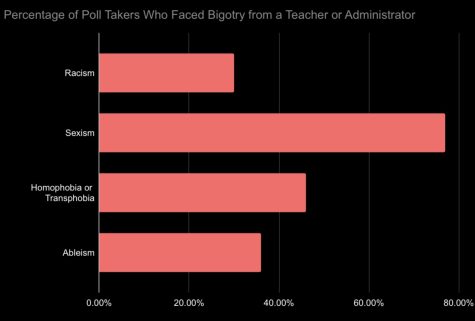Bigotry: a not-so silent disease
Norwin students seek action against the discrimination infecting their school.
For some students, going to school has become a living nightmare, as peers harass them through the halls, day after day. Harassed students have tried everything to make it stop, but nothing seems to work. If that was not bad enough, sometimes teachers and administrators blatantly ignore the bullying going on right in front of them– each day slowly gets harder and harder to bear.
Unfortunately, this is a harsh reality that many marginalized students at the Norwin School District are far too familiar with; it is damaging their school lives and experience.
A recent study in Edutopia.org found that: “Just over half (50.9 percent) of U.S. middle and high school students reported being verbally harassed at school based on appearance or body size, and the numbers for bullying based on other identity markers were also worrying: race/ethnicity (30.3 percent), gender expression (21.9 percent), sexual orientation (19.4 percent), gender (18.1 percent), religion (18.0 percent), and disability (12.7 percent).”
All throughout the country, marginalized students continue to struggle with harassment and bigotry. If these nationwide numbers were not bad enough, a recent Norwin poll reflected similar sentiments.
According to that Norwin newspaper poll, over 37% of participants reported witnessing or experiencing racism at Norwin multiple times a month. Nearly 42% of poll takers said the same about sexism and ableism, and a whopping 65% of poll takers said they witnessed or experienced homophobia or transphobia multiple times a month. Clearly, this is a serious problem among the Norwin student body.
The discrimination that has seeped through Norwin’s halls has made life increasingly difficult for marginalized students, to the detriment of their social lives and mental health.
“Trying to survive Norwin as a marginalized person can feel like trying to swim through honey,” said an anonymous, queer student of color in an interview. “It feels useless since it seems that everywhere you go you can’t escape it, so at what point should you start asking yourself if it’s worth it? After a while it gets tiring as you make little to no progress… It’s near impossible to learn when it feels like the air around you is filled with people who think you’re disgusting and aren’t even punished when they share their feelings. Norwin is a petri dish for intolerance from almost every corner and this makes it hard to socialize. It’s hard to try and pick out the bigots from the good ones sometimes. After so long, you start to feel like everyone here is against you and that feeling stops you from even attempting to socialize. Life is lonely when you’re stuck in a loop of hatred.”
Bigotry within Norwin is not confined to hallways and peer interactions, however. It is an issue rooted both in and out of the classroom, and to truly attack discrimination within the school distract at it’s core, teachers and administrators must examine how they respond to ignorance, whether it comes from a student or their own personal bias.
Over 76% of participants in a recent Norwin poll reported witnessing or experiencing sexism at the hands of a teacher. Over 44% said the same for homophobia or transphobia. 28% of poll takers said they witnessed or experienced racism coming from a teacher, and 35% said the same for ableism.

In addition to evaluating their own biases, many students are asking their teachers to speak out against both casual bigoted comments and blatant harassment made by students, along with fellow faculty members. The silence these students have been met with in response to their harassment has only heightened the alienation they feel in an environment that is meant to be comfortable and safe.
“I don’t get a lot of outward bigotry from teachers but I find that most of the time they don’t bother to do anything,” said an anonymous transgender student in a interview for the feature. “I have been in multiple classes where kids are harassing me and deadnaming me, even outwardly calling me slurs right in front of the teacher without the teacher doing a thing. I would like to think that they just didn’t hear but it’s so apparent at times that it’s impossible to miss… It’s easy to feel alone and isolated, like an alien that doesn’t belong here just because of my identity.”
Though it may not feel like it at times, the Norwin School District has not remained stagnant in its progress towards a more safe school environment. Norwin faculty members have taken steps to make marginalized students feel more comfortable.
“We have been doing a lot more in the last several years to allow students to express who they are and who they want to be within the classroom,” said an anonymous Norwin faculty member. “I think as we move forward, faculty members should be sensitive of [that expression] and be open to students coming to them.”
Despite the strides Norwin has taken to combat bigotry in recent years, many marginalized students continue to feel unheard by the administrative body.
This was reflected in a recent Norwin poll, where over 90% of participants said they did not think the administration at the Norwin School District was doing enough to combat bigotry within the district.
Clearly, there is still so much work to be done in order to ensure that every student has an equal educational opportunity. Every student has the right to a safe space to learn, and frequent harassment and bigotry takes that space away. Many marginalized students find it difficult to feel pride in their education as this discrimination continues with little to no consequences.
“It honestly makes me hate my school,” said an anonymous Norwin student. “I wish I didn’t have to feel this way but when I see all my peers participating in such hateful behavior, it makes me not have a good opinion of my classmates and my school for letting them get away with it.”
Many Norwin students are speaking loud and clear: they want extreme change made in how the Norwin faculty responds to bigotry within their school. These problems with bigotry are real, and slow progress is simply not acceptable. The Norwin School District needs to ask themselves: Is this what you want your school to represent?
“There needs to be a change in the classroom setting,” said an anonymous student. “We need to start breaking down the lines of what our school district was and creating it for the changing world.”








Kim • Aug 7, 2022 at 7:44 am
This has been going on for years. The bullies have all the protection.